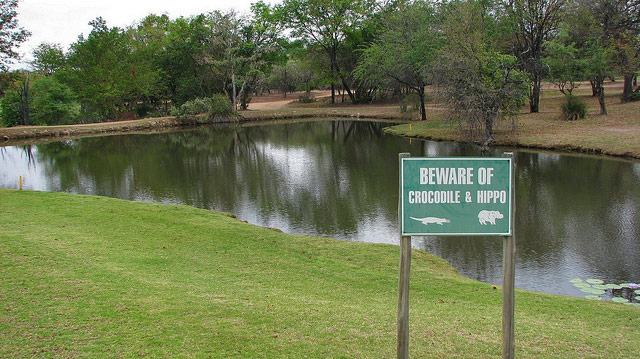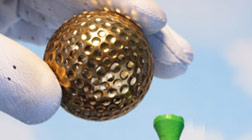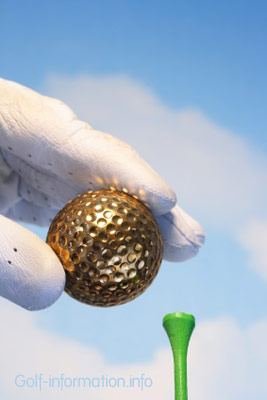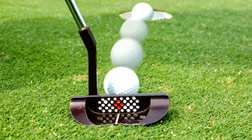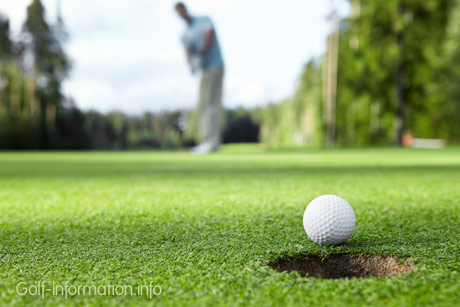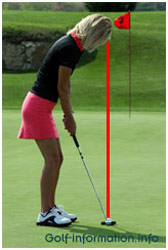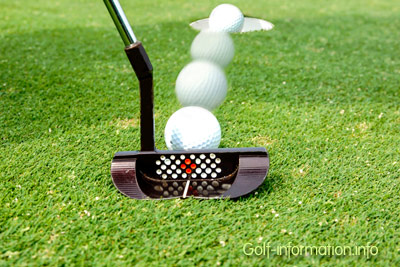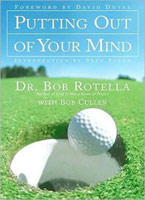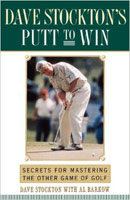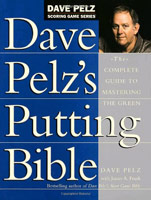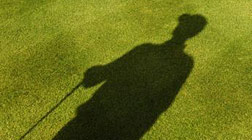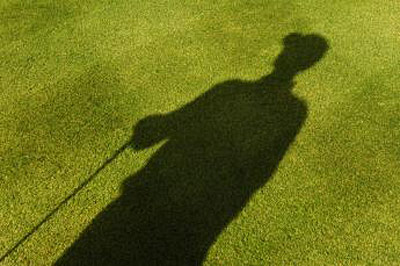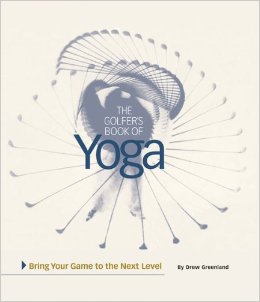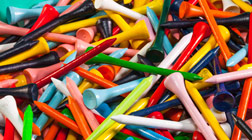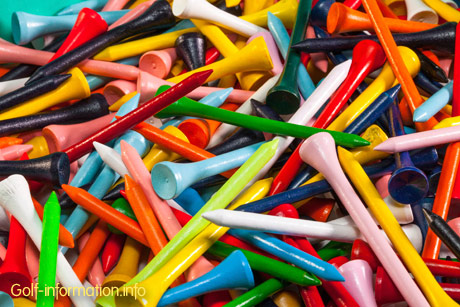Golf balls have evolved throughout the history of the game. Wooden balls were used until the early 17th century, when the ‘featherie’ ball was invented. Due to its superior flight characteristics, the featherie remained the standard ball for a good two and a half centuries.
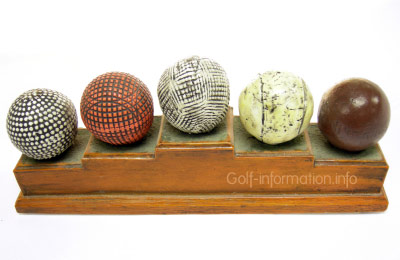
Haskell (c. 1900) Machine Gutty (c. 1880) Gutta Percha (c. 1850) Feathery (c. 1790) Wooden (c. 1590)
Photo by David Kahn
1. The Feathery ball
A featherie is a hand sewn leather-covered ball stuffed with boiled and compressed goose feathers and coated with paint.
Featherie balls were a great improvement as compared to the wooden ball, but they were quite expensive and not perfectly spherical, which gave often gave them an irregular and unpredictable trajectory. An added disadvantage was that when the ball became wet, the stitches in the ball would rot, and the ball would also split open after hitting a hard surface.
2. The Gutta Percha Ball
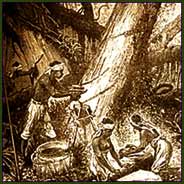
For these reasons the featherie was replaced by the gutta percha ball from 1848. Gutta percha is a hard, resilient, easily molded substance derived from the sap of several Malaysian trees of the family Sapotaceae (Sapodilla Tree), of which golf balls and the cover of golf balls were made until the beginning of the 20th century. The sap had a rubber-like feel and could be made round by heating and shaping it while hot.
Gutta percha balls were first painted white in an attempt to hide the dark-colored gutta sap.
The new ball flew farther than the feathery and was much less expensive, bringing the game within the reach of the less well-off. It also made standardization easier, bringing the game to a higher level of precision.
With the industrialization the production of Gutties became mechanized. They were being made in moulds and could be manufactured with textured surfaces which further increased their aerodynamic qualities, affordability and consistency. Players had noticed that the perfectly spherical and smooth surface of the guttie did not fly as far as the scored featherie. Thus, makers started creating intentional defects in the surface to have a more consistent ball flight. Hand-hammered gutta-percha golf balls could be purchased at least by the 1860’s, and the most notable pattern of the period, the ‘Bramble’ with raised, round, bumps bumps rather than dents was in style from the late 1800’s to 1908.
The “gutty” was prone to break up in mid-air, thus forcing the rules to be adjusted and allowing the golfer to play a fresh ball from the point where the largest fragment had come to rest. This would be the last occasion on which the Rules of Golf had to be amended to adapt to the properties of the golf ball and not vice versa.
3. The rubber core ball and wound ball
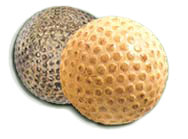
In 1898, a wealthy American amateur golfer named Coburn Haskell, along with Goodrich Rubber company engineer Bertram Work, introduced the rubber cored wound ball. The “Haskell”, as it became known, was universally adopted by 1901 after it proved so effective in the British and US Opens. These balls looked just like Gutties but were made of rubber twine wound around a solid rubber core, and covered in gutta purcha.
Alternatively, Balata was sometimes used as a cover material for golf balls. Balata is a hard, resilient substance derived from the gum of the bully or balata tree (Manilkara bidentata). Balata covers can still be found today in the more expensive range of golf balls.
With the creation of an automatic winding machine coupled with the use of a bramble cover facilitated greater control, the average golfer gained an extra 20 yards from the tee with these new generation golf balls. Manufacturers fine-tuned the length, spin and “feel” characteristics of balls. Wound balls were especially valued for their soft feel.
Research went into the role played by covers and in the first two decades of the twentieth centry, players were able to select from at least 200 different named balls. In 1908, an Englishman, William Taylor, received a patent for a golf ball with indentations (dimples) that flew better and more accurately than golf balls with brambles. A. G. Spalding & Bros., purchased the U.S. rights to the patent and introduced the GLORY ball featuring the TAYLOR dimples. Until the 1970s, the GLORY ball, and most other golf balls with dimples had 336 dimples of the same size using the same pattern, the ATTI pattern. The ATTI pattern was an octohedron pattern, split into eight concentric straight line rows, which was named after the main producer of molds for golf balls.
Other inventions included covers of varying thickness and with multiform markings, from bramble (as mentioned earlier, made of raised, spherical bumps) to recessed crescent moons and triangles each of which was claimed to outfly the others. and squares (“mesh”). The only real innovation related to the surface of a golf ball during this sixty year period came from Albert Penfold who invented a mesh-pattern golf ball for Dunlop. This pattern was invented in 1912 and was accepted until the 1930’s.
Today, the patterns have been replaced by dimples, which accentuate the effects of lift and minimize the amount of drag on the ball. Their exact shape and overall distribution is a continuing matter of intense study by manufacturers.
See golf ball facts >>
In the 1930’s through the 1960’s, the major innovations in golf balls related to core development. The first wound balls consisted of a solid or liquid-filled core wound with a layer of rubber thread and a thin outer shell. In the 1960’s, the development of ionomer materials, particularly the brand SURLYN.RTM. from Du Pont, became the major innovation for golf balls into the 1980’s. In the 1970’s, dimple pattern innovations also appeared from the major golf ball manufacturers. In 1973, Titleist introduced an icosahedron pattern which divides the golf ball into twenty triangular regions. In the late 1980’s and into the 1990’s, three-piece solid golf balls, as opposed to three-piece wound, began to appear from the major golf ball manufacturers. These three-piece solid golf balls involved two thermoplastic layers covering a core.
4. Multi-layer balls
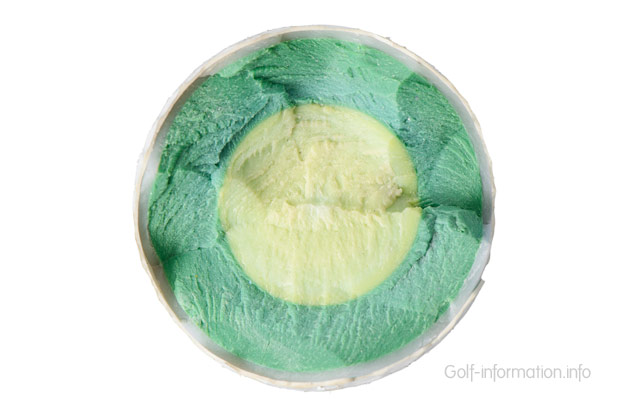
Stock photo © theJIPEN
In the second half of the 20th century, multi-layer balls were developed. They usually consist of a three-, or four-layer design, (named either a three-piece, or four-piece ball) consisting of various synthetic materials like surlyn or urethane blends. They come in a great variety of playing characteristics to suit the needs of golfers of different abilities.
Several patents have been filed for four-piece golf balls, but not all have been commercialised. One example is Sun, U.S. Pat. No. 5,273,286 for a Multiple Concentric Section Golf Ball, which was filed in 1992. Sun discloses a golf ball with a solid inner core, a graphite intermediate core, a polybutadiene outer core and a cover composed of balata, ionomer or urethane materials.
Some Japanese manufacturers, as well, filed patents for innovative four-piece balls. One discloses a golf ball with a liquid filled core, a wound layer over the core, and inner and outer cover layers composed of an ionomer material. The primary objective of Maruko is to provide a golf ball with good distance, well-defined spin and greater durability. Another one discloses a golf ball with a rubber solid core containing an oil substance, an oil-resistant coating layer, a wound layer and an ionomer cover layer.
The solid-core Titleist Pro V1 became the first non-wound golf ball to gain wide accepteance among professional golfers. Wound balls all but disappeared from golf.
Many manufacturers have produced balls of new standards but most have been rejected for tournament usage. A few years ago, the USGA banned the Polara ball, claiming that it undermined the integrity of the game. The inventors of the ball engaged the USGA in expensive court proceedings but the prohibition was upheld.
There have been many attempts to develop a golf ball that can do everything for every golfer, a golf ball that has tremendous distance, with exceptional feel and outstanding durability. However, current golf balls have been unable to deliver everything.
See also:
More golf balls
Further reading:
History section golf balls
Space Structures 4: Volume 1 by G. A. R. Parke, C. M. Howard




